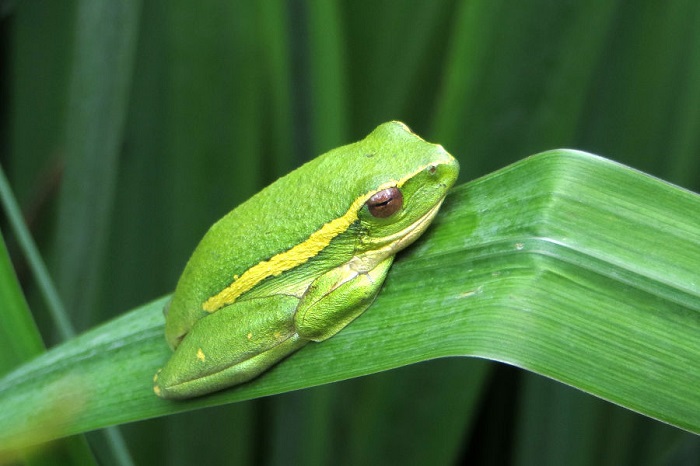View the above photo record (by Geoff Prosser) in FrogMAP here.
Find the Yellow-striped Reed Frog in the FBIS database (Freshwater Biodiversity Information System) here.
Family Hyperoliidae
YELLOW-STRIPED REED FROG – Hyperolius semidiscus
Hewitt, 1927
Habitat
H. semidiscus inhabits a variety of vegetation types in the Savanna Biome, usually in low-lying areas. It breeds in moderately deep rivers, pans and dams that are surrounded by dense reed beds and other emergent vegetation (Lambiris 1989a; Alexander 1990; Channing 2001).

Photo by Faansie Peacock
Behaviour
During the non-breeding season (winter), these frogs can be found several kilometres away from their breeding sites. The breeding season extends through spring and summer, starting after the first substantial spring rains. In Durban (2931CC), males call during December and January from reeds over water, or from floating vegetation (Alexander 1987). In water bodies infested with Water Hyacinth Eichhornia crassipes, males use these plants as both call sites and as retreats while inactive; in some cases, the presence of Water Hyacinth appears to facilitate larger choruses. In dams surrounded by exotic trees, males have been seen calling in pine trees at a height >2 m (P.J. Bishop pers. comm.).
About 200 eggs are laid in clusters of c.30, loosely attached to vegetation just below the surface of the water (Wager 1986).

Photo by Felicity Grundlingh
Status and Conservation
Although H. semidiscus is found in several established conservation areas, its restricted distribution makes it vulnerable to environmental change and it may require additional conservation measures for long-term survival. Because of the paucity of existing information, monitoring of selected populations along with a detailed study of the distribution and life history of this species, are recommended.

Photo by Gary Nicolau
Distribution
H. semisdiscus is endemic to the atlas region, although its distribution suggests that it may also occur in southern Mozambique, and it should be looked for there. It is distributed along the coast of Eastern Cape Province from Port Elizabeth (3325DC, DD) northward through KwaZulu-Natal to northeastern Swaziland (2632AA), and inland as far as Nelspruit (2530BD). The Baviaanskloof record (3324CB) is based on a photo (L. Creig) and further surveying is required to assess populations in that area.
H. semidiscus and H. argus are morphologically similar, although slight differences in snout width and markings have been noted (Poynton 1964; Passmore and Carruthers 1995). The two species may be easily distinguished, however, by clear differences in their advertisement calls (Passmore and Carruthers 1995). The atlas data are reasonably reliable but incomplete; the gaps in the mapped distribution probably reflect inadequate sampling rather than actual discontinuities.

Further Resources
Virtual Museum (FrogMAP > Search VM > By Scientific or Common Name)
More common names: Geelstreep-rietpadda (Afrikaans)
Recommended citation format for this species text:
Alexander GJ, Tippett RM. Yellow-striped Reed Frog Hyperolius semidiscus. BDI, Cape Town.
Available online at http://thebdi.org/2022/02/04/yellow-striped-reed-frog-hyperolius-semidiscus/
Recommended citation format:
This species text has been updated and expanded from the text in the
2004 frog atlas. The reference to the text and the book are as follows:
Alexander GJ 2004 Hyperolius semidiscus Yellow-striped Reed Frog. In Minter LR
et al 2004.
Minter LR, Burger M, Harrison JA, Braack HH, Bishop PJ, Kloepfer D (eds)
2004. Atlas and Red Data Book of the Frogs of South Africa, Lesotho and
Swaziland. Smithsonian Institution, Washington, and Avian Demography
Unit, Cape Town.

